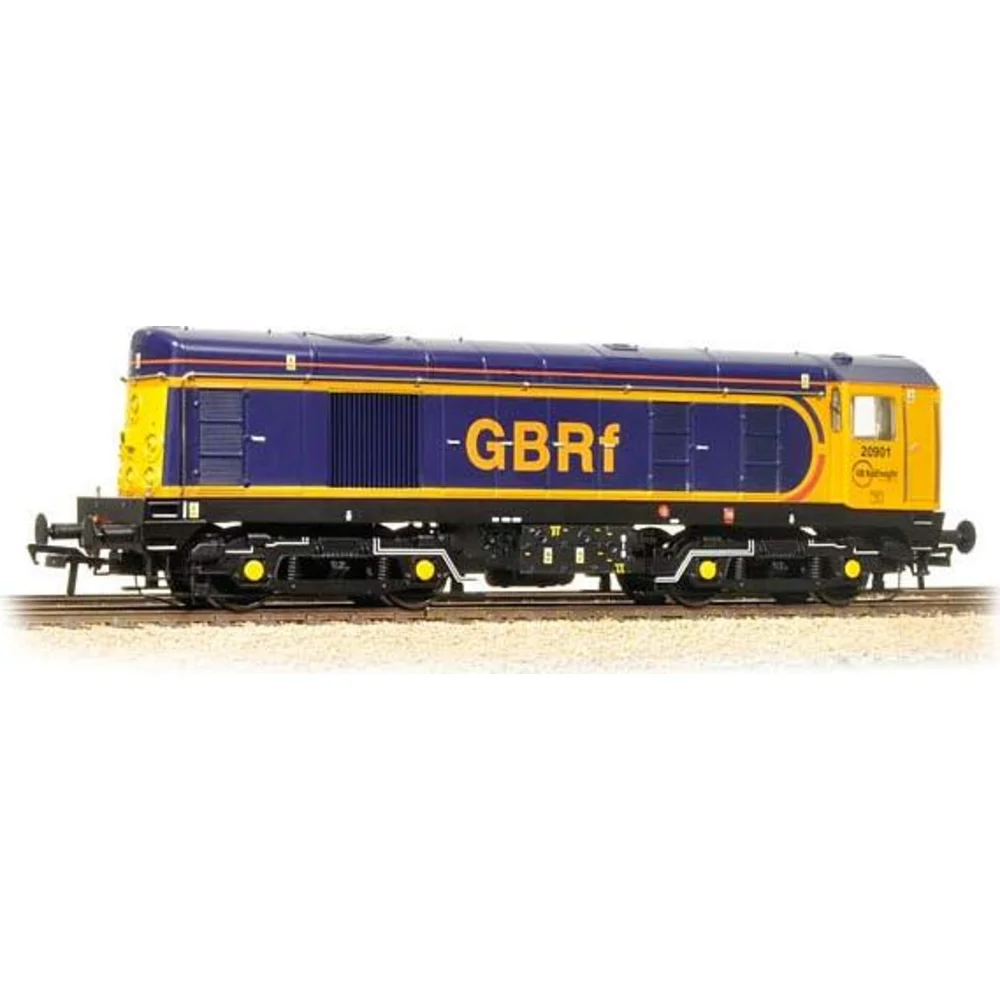Bachmann 32-037
British Rail Class 20 20901 GB Railfreight Blue & Orange
Tooling
In 2008, Bachmann introduced an upgraded Branchline Class 20, improving upon the original 2004 tooling. This version brought a number of refinements across detailing, mechanicals, and coachability to align with evolving model standards.
Tooling Features
Scale & Construction: OO gauge (1:76); plastic bodyshell with diecast chassis and bogies.
Detailing: Factory-fitted etched fan grills, piped handrails, lamp irons, tablet catcher apparatus, separate snowplough, and bufferbeam pipework.
Fully-detailed cab interior, window wipers, painted battery boxes, sandgear, footsteps, and chemically-blackened wheels.
Couplings: Tension-lock couplings in NEM pockets; sprung buffers added.
Mechanical & Electrical
Motor & Drive: Five-pole motor with twin shafts, all-axle drive via diecast gearbox and flywheels; all-wheel pickup.
Minimum Radius: Suitable for Radius 2 curved track (approx. 438 mm).
Weighting: Chassis-integrated ballast provides solid traction.
Lighting: Directional headlights (including high-intensity variants) at both ends, cabin lighting with selectable day/night mode.
Assembly: Body secured with screws; additional detailing parts included in a detailing pack.
DCC Capability
The 2008 tooling upgraded DCC readiness with a 21-pin socket and provision for a speaker. Lighting functions and pluggable wiring were designed around future decoder and sound installations.
Liveries Produced
This tooling supported an extensive range of genuine liveries, including:
- BR green (early & late crest)
- BR blue (disc and headcode box)
- Railfreight grey (including red stripe & triple-grey sectors)
- GB Railfreight, London Underground, Hunslet-Barclay, Waterman, DRS
- Limited editions such as London Transport and special scheme releases
Reviews & Commentary
Model reviews applauded the enhanced fine detailing, realistic underframe pipework, and fully glazed and lit cab interior. The improved running characteristics—especially low-speed performance—were highlighted, though minor cogging was occasionally noted during the slowest operation.
Media and Social Media
Unboxing videos and forum discussions underlined the step-up in quality versus the earlier tooling. Enthusiasts expressed particular appreciation for the DCC-ready socket, directional lighting, and the diversity of liveries offered. Some debates focused on the optionality of snowplough fittings and detailing pack usage for customisation.
Other Interesting Notes
- This upgrade marked Bachmann’s move to a 21-pin DCC interface, anticipating sound decoder adoption.
- Sprung buffers and improved bogie detailing were firsts for the Class 20 tooling.
- This tooling remained current—prior to the 2021 retooling—setting the benchmark for branchline diesel modelling.
Class & Prototype
- Class: British Rail Class 20
- Traction: Diesel
- Transmission: Electric
- Built: 1957-1968
- Total Built: 228
The BR Class 20 (English Electric Type 1) served British railways from 1957-2025 as one of the most successful diesel designs ever built. With 228 locomotives constructed 1957-1968, these distinctive single-cab "hood units" became famous for their reliable English Electric 8SVT 1,000 hp engines, characteristic nose-to-nose paired operation, and beloved "Chopper" exhaust sound. They worked cross-London freights, Yorkshire coal trains, MGR operations, and modern nuclear flask services. Outstanding models available from Bachmann (OO), Graham Farish (N), and Heljan (O) in liveries from BR Green through DRS Blue.
No prototype found.
Operator & Livery
- Operator: GB Railfreight
- Livery: Blue & Orange
GB Railfreight (GBRf) is the UK's third-largest rail freight operator, established in 1999 and currently owned by Infracapital (M&G plc subsidiary). Operating over 2,000 trainloads weekly with an exceptional 99% reliability rate, the company moves approximately 23% of Britain's rail freight using a fleet of 170 locomotives and 1,800 wagons. GBRf serves major ports including Felixstowe, Southampton, and London Gateway with 54 daily intermodal services nationally, whilst also providing vital infrastructure services for Network Rail, London Underground, and major construction projects like HS2.
The company is renowned for pioneering the innovative Class 69 conversion programme, transforming redundant Class 56 locomotives with modern EMD 710 engines, and for operating diverse heritage livery schemes that celebrate British railway history. With headquarters and control centre in Peterborough and maintenance facilities at Tonbridge, GB Railfreight employs over 1,400 people and has committed to achieving net-zero operations by 2050, positioning itself as a leader in sustainable freight transport whilst maintaining strong partnerships with customers including Network Rail, Drax, Aggregate Industries, and major shipping lines.
The first batch of Class 66s, delivered in 2001, introduced GB Railfreight’s original Blue & Orange livery. This featured a dark blue body with bold orange cantrail stripes and orange cab sides extending back to the inner edges of the cab doors, combined with high-visibility yellow front ‘bib’ panels. Large orange “GBRf” lettering dominated the bodysides, with running numbers applied prominently at the cab ends. This striking yet simple scheme established the corporate identity that has underpinned GBRf’s visual branding ever since.
